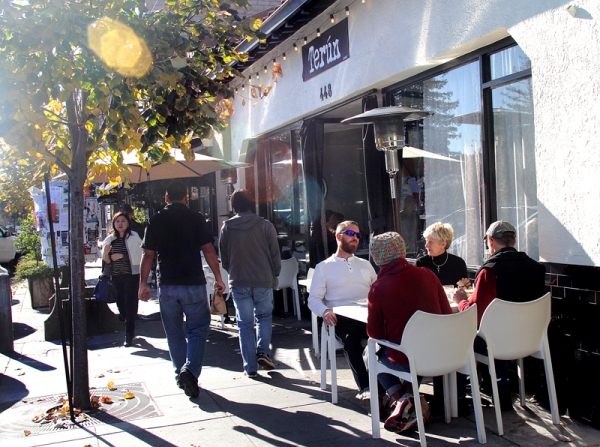As Palo Alto officials prepare to give California Avenue an extreme makeover, the arty, eclectic and under-maintained thoroughfare has been quietly undergoing an economic resurgence, with restaurant activity on the upswing and tax-revenues climbing steadily.
Once the most prominent thoroughfare of the Town of Mayfield, the commercial strip near the city's geographical center has long filled a role as the smaller, funkier and slightly more disheveled sibling of downtown's University Avenue.
But California Avenue's economic engine has been quietly revving up since 2010, according to a commissioned report from the firm MunicServices, LLC. The cash receipts from the California Avenue area have risen 24 percent between the second quarter (the period from April and June) of 2010 and the second quarter of 2013, when they totaled $1.1 million.
Though that still pales in comparison to Stanford Shopping Center (which brought in $5.5 million in the second quarter of 2013) and downtown (which brought in $3 million), the commercial district around California Avenue is the only area that has seen growth in every single quarter since 2010.
Tommy Fehrenbach, the city's economic-development manager, told the Weekly that the consistently strong numbers on California Avenue reflect the solid performance of the area's dining scene. He noted that the receipts include not just California Avenue but the areas around it, including the portion of El Camino Real where Chipotle Mexican Grill, Jack in the Box and the Olive Garden do business. The economic performance of other types of businesses, he noted, have remained relatively flat.
"Restaurant activity has been increasing, and that pretty much tells the story of the increase in the area," Fehrenbach told the Weekly.
The numbers spell good news for the City Council, which has taken a series of actions in the past four years aimed at turning California Avenue into the city's "second downtown," on par with University Avenue and Mountain View's Castro Street. The most costly and controversial component of this effort is the ambitious streetscaping project, which is set to unfold next year and which will shrink California Avenue to two lanes, expand the sidewalks, add new streetlights and create flexible "plaza" spaces capable of accommodating major public events.
The area also figures prominently in the city's long-term vision. Because of its proximity to a Caltrain station and to El Camino, city officials have designated it as Palo Alto's sole "priority development area," making it eligible for regional grants to support projects that include new housing. Over the past four years, the city has also been crafting a plan for the broader California Avenue area, which includes Fry's Electronics. The plan's vision is to create an "attractive, transit-rich neighborhood shopping district," and its proposals include a design competition for new parking structures; new incentives for mixed-use developments; more bike parking and improved shuttle connections between California Avenue and the Stanford Research Park.
At a Planning and Transportation Commission meeting last week, Commissioner Michael Alcheck waxed ecstatic about the California Avenue area, calling it "an epicenter" and urging the city to "start to appreciate" the area's critical role.
"When people say real estate is about three things — location, location, location — this is the kind of thing we're talking about." Alcheck said at the Nov. 20 meeting.
Even without the city's grand plans, the area has been undergoing a market-driven transformation, with young technology companies, including Groupon and Yelp, recently opening offices near the prominent commercial strip and developers pitching new office projects, some of which involve density that far exceeds zoning regulations. One potentially transformative project for the area is Jay Paul's proposed development at 395 Page Mill Road, which would add 311,000 square feet of office space next to AOL's headquarters. The project also involves building the city a new police headquarters at a nearby site, 3045 Park Blvd.
These changes promise to beget others. Almost every large new development in the area, — including Harold Hohbach's research space and housing project at 195 Page Mill Road and the recently approved four-story building around Equinox Gym at 3159 El Camino Real — includes as part of the package new plazas, bike lanes and various pedestrian improvements. One change proposed by Jay Paul, for example, is a new pedestrian route that would fill a void between the Caltrain station and the proposed development. And in the latest nod to the area's growing high-tech prominence, the bus company RidePal in September announced its new operation around California Avenue, which promises to give area commuters a "Google shuttle" experience.
Underscoring the importance of the area and the council's desire to turn it into a second University Avenue, council members in February officially adopted "the future of downtown and California Avenue" as one of its three official priorities for 2013.



Comments